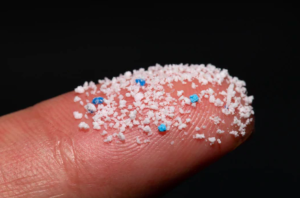
People & Culture
On thin ice: Who “owns” the Arctic?
As the climate heats up, so do talks over land ownership in the Arctic. What does Canadian Arctic Sovereignty look like as the ice melts?
- 4353 words
- 18 minutes
Environment

A team of researchers from the University of Rhode Island has found unusually high concentrations of microplastics in thick Canadian Arctic ice, raising concerns that plastic pollution has spread to even the most remote regions on Earth.
During an 18-day expedition through the Northwest Passage last month, the team sampled ice cores more than two metres thick in Lancaster Sound, a body of water between Devon and Baffin Islands. Initially, they were looking for plankton, but what they found was alarming.
“It was clear there was a lot more in the ice cores than just organic matter,” says Brice Loose, an associate professor of oceanography at the university who supervised the expedition. “And this is something that’s more unique to ice than to seawater. You can certainly find plastic in seawater if you look hard enough, but the abundance and concentration in the ice was really striking.”
Alessandra D’Angelo, a graduate student who took part in the expedition, says not only was the amount of plastic in the ice notable, but the size of the pieces as well.
“The most shocking thing was to find microbeads of more than 50 micrometres, which is big for us,” she says. “It’s unbelievable.”
Microplastics are plastics that are smaller than five millimetres. D’Angelo says the researchers found filaments up to one millimetre long.
“We thought it would be hard to distinguish the plastic from the plankton, but it was very easy because the plastic has a different shape, a different colour,” she says. “And there was so much.”
John Nightingale, senior ocean science advisor with One Ocean Expeditions, whose ‘One Lab’ installation on board the RCGS Resolute gathers water samples for microplastics analysis as the ship travels from place to place, says the occurrence of microplastics in Arctic waters underscores how intermixed the world’s oceans are.
“We need to talk about just having one ocean,” he says. “If you have a piece of microplastic and you give it long enough, it will travel the ocean currents and end up everywhere — including the Arctic.”
The research team at the University of Rhode Island believes the ice cores they sampled drifted into Lancaster Sound from the central Arctic over the last year — but the microplastics likely came from much further away.
According to Jacob Strock, another graduate student who took part in the expedition, Lancaster Sound receives influxes of water from multiple ocean basins.
“Our leading hypothesis is that [the microplastics] probably came from somewhere in the Pacific Ocean,” says Strock.
Water also enters the Arctic from the Atlantic Ocean, but Nightingale says that the net flow of water in the Canadian Arctic is from west to east, entering between Alaska and Russia and exiting by Iceland.
“Most of the microplastic [in the Arctic] is in the water coming in from the Pacific,” he says. “How much is being added in the Arctic itself? Probably not a lot.”
Loose says atmospheric transport may also be a possibility, pointing to a separate discovery of microplastics around the same time in Arctic snow at Fram Strait. That European-led study proposed that a likely mode of transport for those microplastics was by air.
“It suggests some of this stuff is small and light enough to be blown by air massed and deposited from the atmosphere,” says Loose. “The same thing is plausible for the plastic we found in the sea ice cores.”
Nightingale says the reach of plastic pollution is particularly troublesome for plankton living near the surface in Arctic waters and for migratory species that use the Northwest Passage..
“[Microplastic] doesn’t float on the surface,” he says. “It floats somewhere in the water column, usually in the top three to four metres.”
Plankton have been shown to ingest microplastic, which then bioaccumulates in whales and other predators up the food chain — including humans.
The long-term effects of that, Nightingale says, are still not well understood.
“At what point do some of those [plastics] go across either their blood barrier or our blood barrier and begin to clog up our kidneys?” he says. “It’s a disturbing thought, and the research is just starting to get into it.”
Loose says his students now plan to take measurements of the types of microplastics they found and how they degrade in hopes of figuring out how that might affect life around the Lancaster Sound region.
“These are carbon based materials,” says Strock. “Will they degrade into greenhouse gases?”
D’Angelo wants to look specifically at methane production from the degradation of microplastics, stressing the effect human activity much farther south can have on the far North.
“All the oceans are connected by a conveyor belt, by currents,” she says. “If we do something in our house, it’s not something that stays isolated.”
Are you passionate about Canadian geography?
You can support Canadian Geographic in 3 ways:

People & Culture
As the climate heats up, so do talks over land ownership in the Arctic. What does Canadian Arctic Sovereignty look like as the ice melts?

Environment
The uncertainty and change that's currently disrupting the region dominated the annual meeting's agenda

Environment
A team of Canadian researchers has found evidence that microplastics and microfibers have infiltrated Arctic ecosystems, but the source of these tiny fragments is still unclear

Environment
Doing your part as an eco-conscious consumer doesn’t end once you buy a bioplastic product